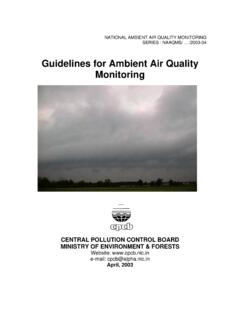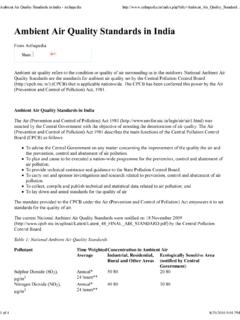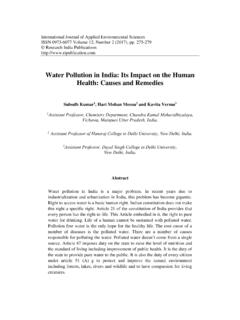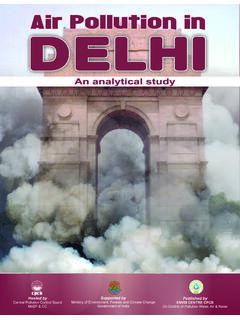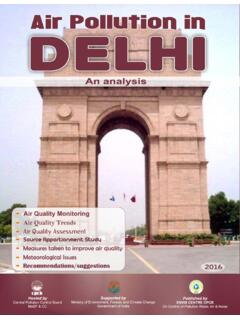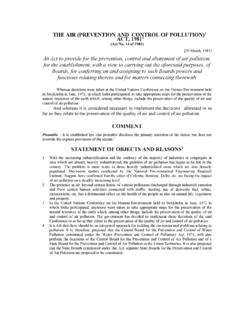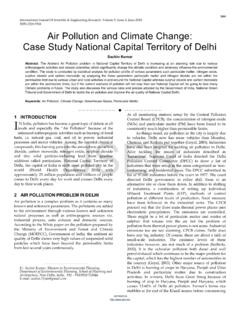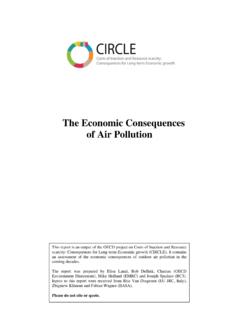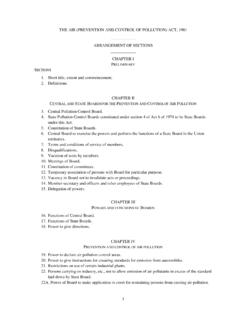Transcription of NATIONAL AIR QUALITY INDEX
1 Control of Urban pollution Series:CUPS/ 82 /2014-15 NATIONAL AIR QUALITY INDEXPl\ntoAQI: 95; SatisfactoryResponsible Pollutant: P M"tilksCLEANWg/CENTRAL pollution CONTROL BOARDM inistry of Environment, Forests & Climate ChangeWebsite: FrfaaSHASHI SHEKHAR, IASS pecial SecretaryMEZIF ITTUT -11A41 ChairmanCENTRAL pollution CONTROL BOARD i s1c'Ic1I 4 to41 -14 - 110003 GOVERNMENT OF INDIAMINISTRY OF ENVIRONMENT, FOREST &CLIMATE CHANGENEW DELHI-110003 ForewordAir pollution levels in most of the urban areas have been a matter of serious concern. It isthe right of the people to know the QUALITY of air they breathe.
2 However, the data generated throughNational Ambient Air Monitoring Network are reported in the form that may not be easilyunderstood by a common person, and therefore, present system of air QUALITY information does notfacilitate people's participation in air QUALITY improvement view of this, CPCB took initiative for developing a NATIONAL Air QUALITY INDEX (AQI) forIndian cities. AQI is a tool to disseminate information on air QUALITY in qualitative terms ( good,satisfactory, poor) as well as its associated likely health impacts. An Expert Group comprisingmedical professionals, air QUALITY experts, academia, NGOs, and SPCBs developed NATIONAL technical information was provided by IIT Kanpur.
3 The draft AQI was launched in October2014 for seeking public comments. It was also circulated to States Governments, pollution ControlBoards, concerned Central Government Ministries and premier research institutes for received were examined by the Expert Group and a NATIONAL AQI scheme was finalized,which is presented in this report. There are six AQI categories, namely Good, Satisfactory,Moderately polluted, Poor, Very Poor, and Severe. The AQI considers eight pollutants for whichshort-term (up to 24-hourly averaging period) standards are prescribed, however, AQI can becalculated if monitoring data are available for minimum three pollutants of which one shouldnecessarily be or PM10.
4 Based on the measured ambient concentrations, correspondingstandards and likely health impact, a sub- INDEX is calculated for each of these pollutants. The worstsub- INDEX reflects overall gratefully acknowledge the contributions made by the members of the Expert Group andProfessors Mukesh Sharma and Arnab Bhattacharya of IIT Kanpur in finalizing the AQI scheme andpreparation of this report. The efforts made by my colleagues Dr. Prashant Gargava, AdditionalDirector, who conceptualized and coordinated the project and Ms. Garima Sharma, EnvironmentalEngineer, CPCB are appreciated.
5 Efforts put in by Shri A. Sudhakar, Additional Director; Shri AdityaSharma, Environmental Engineer; and Ms. Kavitha B., Environmental engineer for operating webdissemination AQI system is also is hoped that the AQI will provide more meaningful air QUALITY information to the people,ensure everyone's participation to strengthen efforts being made for improving air QUALITY in urbanareas.(Shashi Shekhar) 3/i7/rChairmanttft*IT '', 'TIT -311T1FR tral 374*TIT, 1-4 ml I - 1 1 0 0 32'PARIVESH BHAWAN'. COMPLEX, EAST ARJUN NAGAR, DELHI-110 032 PHONE : 22307233, TEL.
6 FAX : 22304948, E-mail : @nicin, Chapter 1 Introduction Origin and Concepts of Air QUALITY INDEX In addition to land and water, air is the prime resource for sustenance of life. With the technological advancements, a vast amount of data on ambient air QUALITY is generated and used to establish the QUALITY of air in different areas. The large monitoring data result in encyclopaedic volumes of information that neither gives a clear picture to a decision maker nor to a common man who simply wants to know how good or bad the air is?
7 One way to describe air QUALITY is to report the concentrations of all pollutants with acceptable levels (standards). As the number of sampling stations and pollution parameters (and their sampling frequencies) increase, such descriptions of air QUALITY tend to become confusing even for the scientific and technical community. As for the general public, they usually will not be satisfied with raw data, time series plots, statistical analyses, and other complex findings pertaining to air QUALITY . The result is that people tend to lose interest and can neither appreciate the state of air QUALITY nor the pollution mitigation efforts by regulatory agencies.
8 Since awareness of daily levels of urban air pollution is important to those who suffer from illnesses caused by exposure to air pollution , the issue of air QUALITY communication should be addressed in an effective manner. Further, the success of a nation to improve air QUALITY depends on the support of its citizens who are well-informed about local and NATIONAL air pollution problems and about the progress of mitigation efforts. To address the above concerns, the concept of an Air QUALITY INDEX (AQI) has been developed and used effectively in many developed countries for over last three decades (USEPA 1976, 2014; Ontario, 2013; Shenfeld, 1970).
9 An AQI is defined as an overall scheme that transforms weighted values of individual air pollution related parameters (SO2, CO, visibility, etc.) into a single number or set of numbers. There have not been significant efforts to develop and use AQI in india , primarily due to the fact that a modest air QUALITY monitoring programme was started only in 1984 and public awareness about air pollution was almost non-existent. The challenge of communicating with the people in a comprehensible manner has two dimensions: (i) translate the complex scientific and medical information into simple and precise knowledge and (ii) communicate with the citizens in the 2 historical, current and futuristic sense.
10 Addressing these challenges and thus developing an efficient and comprehensible AQI scale is required for citizens and policy makers to make decisions to prevent and minimize air pollution exposure and ailments induced from the exposure. Applications of Air QUALITY INDEX Ott (1978) has listed the following six objectives that are served by an AQI: 1. Resource Allocation: To assist administrators in allocating funds and determining priorities. Enable evaluation of trade-offs involved in alternative air pollution control strategies.
